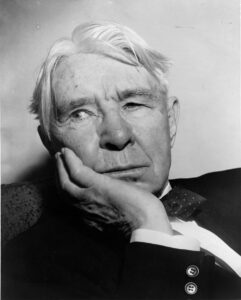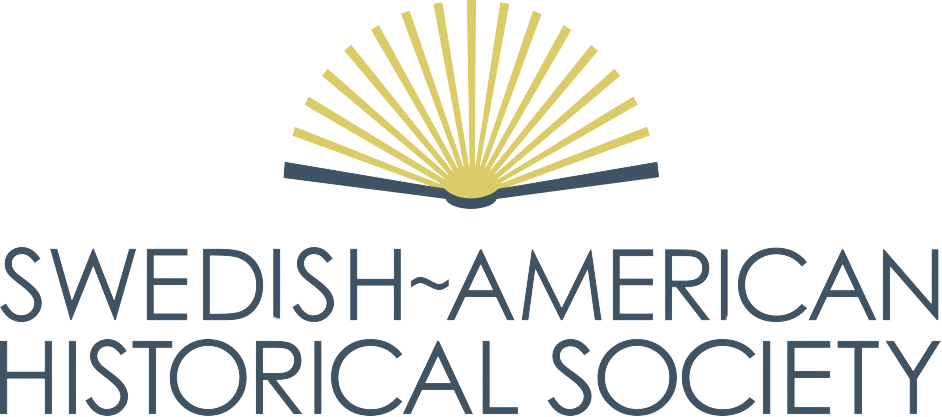Carl Sandburg (1878 – 1967) was a Swedish-American poet, biographer, journalist, and editor. He won three Pulitzer Prizes: two for his poetry and another for one of his multi-volume biographies of Abraham Lincoln. He was a towering figure in twentieth-century American literary life. Yet he was also the Honorary Chairman of the Swedish Pioneer Historical Society from its formation in 1948 until his death in 1967.
How did such a literary giant get connected with the Society?
Carl August Sandburg was born in the Swedish-American community of Galesburg, Illinois. His parents, Clara Mathilda Anderson Sandberg and August Sandberg, were immigrants from Östergötland, Sweden. Carl sometimes went by Charles or Charlie in his family, and he and his two oldest siblings changed the spelling of their last name from Sandberg to Sandburg.
Later Carl, his wife (Lilian “Paula” Steichen), and their first daughter moved to the Chicago area around 1912 when he was offered a job with a Chicago newspaper. He was already writing poetry. One of his most celebrated poems came out in 1914, “Chicago,” that popularized the image of Chicago as the ‘City of the Big Shoulders.’
Carl Sandburg won his first Pulitzer Prize in 1919, this one in Poetry, for his volume Corn Huskers. Carl won the Pulitzer Prize again in 1940, this time in History, for his four-volume biography of Abraham Lincoln entitled Abraham Lincoln: The War Years. He would later win a third Pulitzer Prize, once again in Poetry, for his Complete Poems in 1951.
In 1928, a mutual friend introduced Carl to Vilas Johnson in Chicago. Vilas was a Swedish American originally from Rockford, Illinois. Carl and Vilas became close friends. Vilas became a partner in the Arthur Andersen and Company accounting firm (he married a daughter of Arthur Andersen), serving from 1932-1952. He later became the Director of the World Trade Division of the Chicago Association of Commerce and Industry.

Twenty years after they first met, in 1948, Vilas became the Chicago Chairman of the Swedish Pioneer Centennial celebration. In that role, Vilas invited Carl to speak to the crowd of 18,000-20,000 Swedish Americans crowded into the Chicago Stadium on 4 June 1948. President Harry Truman, Sweden’s Prince Bertil, and other celebrities were on the stage as well. But the crowd stayed late into the night to hear Carl Sandburg speak.
As Vilas remembered it,
“He started out in his usual slow rambling manner, talking about his boyhood in a Swedish home, how they entertained their fellow Swedes, his father, his mother, all poured forth in melodious tones ranging from a murmur to something close to a shout. This was Carl Sandburg at his best. It was the opportunity of his life to express his deep feeling for his Swedish heritage, for he must have sensed that he would never again have such an audience.”
Vilas continued,
“He finished his speech at 1:15 in the morning, but not a soul left while he spoke.”
After the events of the Swedish Pioneer Centennial had ended, the Swedish Pioneer Historical Society (now the Swedish-American Historical Society) was formed, and Vilas was selected as its first chairman. The new board unanimously voted to ask Carl Sandburg to be the Society’s honorary chairman. Carl’s friend Vilas mailed the formal invitation.
Carl Sandburg graciously accepted the Society’s invitation to serve as Honorary Chairman. He ended his acceptance letter to Vilas writing,
“How proud my Mother would be…her boy, honorary chairman, honorary chairman….Varmaste hälsningar, gode vän.” [Warmest greetings, good friend.]
Carl Sandburg continued to serve as the Society’s Honorary Chairman for nearly 20 years, from 1948 until his death in 1967.
A decade after Sandburg’s death, the Society created its highest award, the Carl Sandburg Medal. The first recipient of the Carl Sandburg Medal, in 1978, was, appropriately, Carl’s old friend, Vilas Johnson, a founder of the Society and its first chair of the board of directors.
